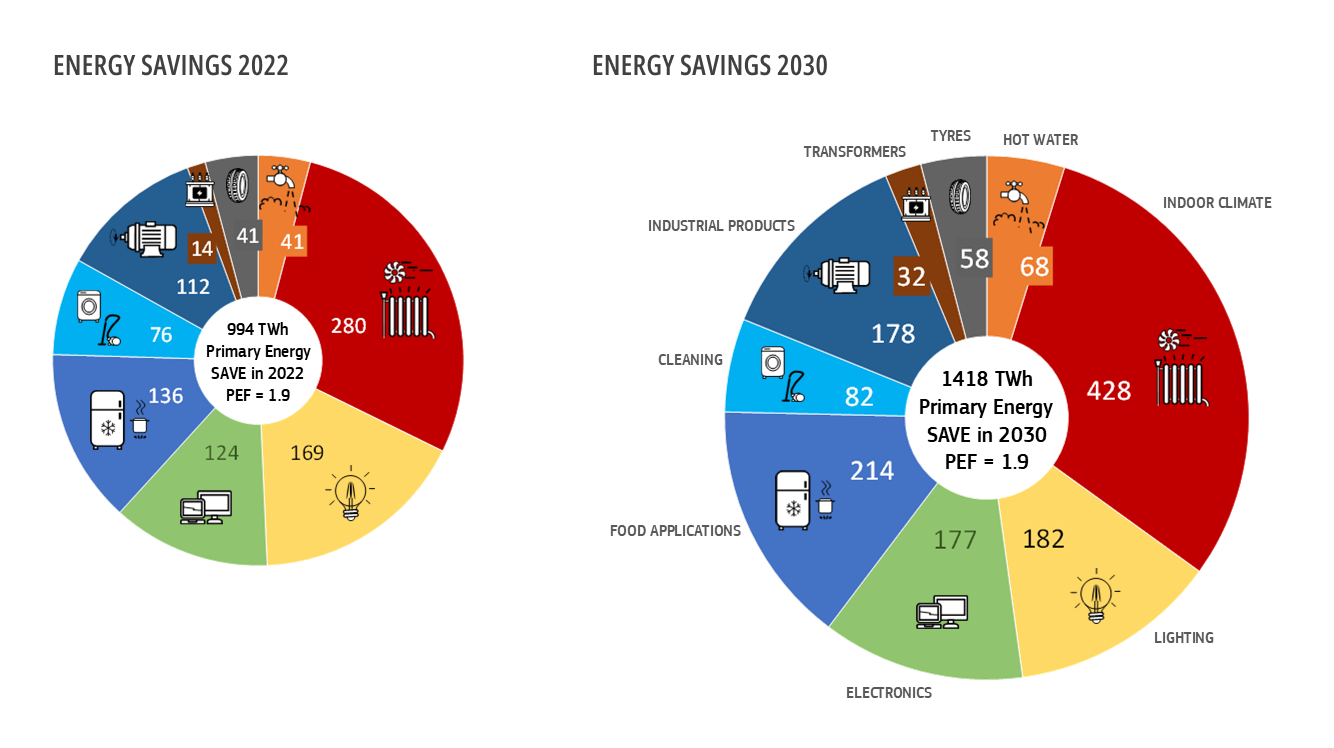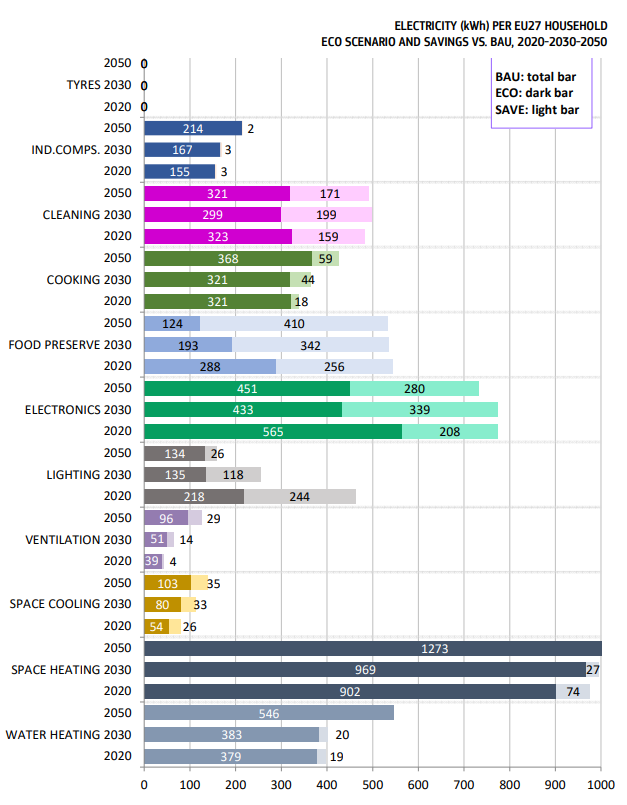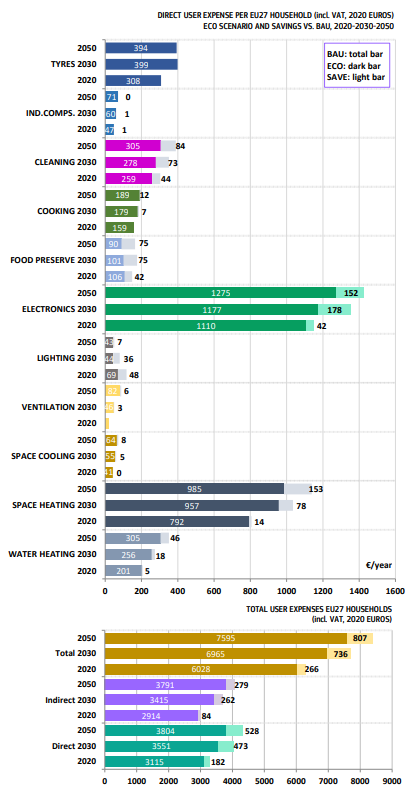Ecodesign
Ecodesign legislation is a powerful tool in driving the industry towards greater energy efficiency and sustainability. Ecodesign regulation has been instrumental in fostering energy-saving innovations: manufacturers are stimulated to develop newer technologies to maximise energy efficiency while minimising waste.
Even when appliances are switched off, standby power consumption contributes to substantial energy wastage and, consequently energy expenditure and greenhouse gas emissions. Ecodesign legislation has addressed this issue by capping power consumption for standby and off modes of household and electronic products. Since its introduction in 2008, the legislation has progressively tightened these limits, prompting manufacturers to design appliances that consume minimal power during periods of inactivity.
By reducing power consumption and aiming for further reductions industry has made significant progress towards greener and more sustainable energy-related products. Ecodesign has been a game-changer that has influenced the production worldwide and stimulated many third countries to introduce similar legislation, “not to become the rubbish dump” of products not sold in the EU.
Ecodesign is benefitting both consumers and the environment. Improved test methods that reflect real-world usage patterns have led to significant energy performance improvements for many appliances, heating/cooling products, industrial products and more.
Ecodesign for Sustainable Products
In 2024, a new regulation that will gradually replace the Ecodesign Directive, has been adopted.
Ecodesign for Sustainable Products Regulation
Implementing the Ecodesign for Sustainable Products Regulation
Ecodesign Horizontal Legislation
Ecodesign regulation 1275/2008 on energy consumption in ‘off’ and various ‘standby’ modes was designed as a horizontal piece of legislation. Read more information about Standby and Networked Standby, Off Mode.
What does the existing Ecodesign legislation cover?
The existing Ecodesign regulations typically include:
- Technical requirements for the physical product typically focused on energy efficiency, emission or general resource efficiency-related aspects. The product needs to fulfil these so-called minimum requirements to be allowed to be placed on the EU market.
- Requirements concerning the availability of spare parts and information for repair and maintenance to increase the expected lifetime of products.
- Information requirements covering the documentation of the product. When placed on the market, the product has to fulfil all technical requirements and information requirements. The documentation confirms the compliance of the product with all requirements of the regulations by the supplier.
Source: Compliance Services
Energy Labelling
Labelling is empowering consumers to make eco-conscious choices: it helps to bring true value to consumers while pushing the boundaries of innovation toward the most energy-efficient solutions. But how can it provide better value for consumers? According to the Special Eurobarometer 492, almost 80% respondents said they take the energy label into consideration upon purchasing a new appliance. This makes evident the importance of the label, as it strives to improve energy efficiency for all actors across the board. Introduced in 1994, EU energy labels have helped provide consumers with as much information as possible on the energy consumption of an appliance, prior to purchase, making transparent the affordances each appliance has to offer when it comes to saving energy and costs, benefitting the consumers' pocket. On the other hand, this transparency and accountability has driven manufacturers towards the development of new technologies and innovations, aimed to provide more energy-efficient solutions, so that their newer models appear in the highest classes of the label.
The energy label helps to bring true value to consumers. Never before has there been such a choice on the market, from how the product is designed, which brand has manufactured the appliance, how energy efficient the appliance is, and, perhaps most importantly, how much the product costs are weighed up by consumers before deciding which appliance to bring home.
The production of increasingly more energy-efficient products helps reduce energy consumption but also preserve natural resources. The European Commission’s proposal to merge different product technologies within the same label brings with it the clear advantage of informing consumers of the best product from a purely energy standpoint.
View more information about the energy label.
Highlights
EU27 Energy Savings 2022 & 2030 From Ecodesign and Energy Labelling

Source: estimations from the Ecodesign Impact Accounting Overview Report 2023
Transition period
What to consider when legislation has been revised
For all regulations a certain period is specified between the publication of a new regulation and the applicability of the specific regulation requirements. This transition period ensures sufficient lead-time for the market actors (including manufacturers, importers distributors, and dealers) to adjust their products and product information for compliance without disruptive effects on production and sales.
Source: Compliance Services
Who does what?
The specific requirements vary depending on your role and the regulations that apply to the product.
The Ecodesign and Energy Labelling regulations describe these six roles:
- Manufacturer: A manufacturer that produces products or lets produce products.
- Authorised representative: An entity with written consent from a manufacturer outside the EU to act on their behalf.
- Importer: An entity that imports products and places them on the EU market (either for money or free of charge).
- Distributor/wholesaler: Any economic operator in the EU supply chain who makes products
available on the market and is not an importer or manufacturer. - Supplier means a manufacturer established in the EU, the authorised representative of a manufacturer who is not established in the EU, or an importer, who places a product on the EU market.
- Dealer means a retailer or other natural or legal person who offers for sale, hire, or hire purchase, or displays products to customers or installers in the course of a commercial activity, whether or not in return for payment.
Please note that economic operators can have several roles and therefore must meet several requirements. A dealer has the same obligations as a supplier, if the dealer e.g., imports products. And a supplier has the same obligations as a dealer if the supplier e.g. import products and sells them to customers.
View the roles of the different economic operators under Ecodesign and Energy labelling
Synergic effect of the Ecodesign and Energy Labelling: the Push & Pull
The Energy label is a legislative instrument synergic with Ecodesign policies.
The Ecodesign legislative framework is intended to set minimum requirements, mostly but not only on energy performance when the product is in its use-phase, but more and more, in the reviews of the regulations on specific products, on the energy and material use over the entire product lifetime. This in turn, influences the carbon emissions.
Ecodesign requirements are mandatory and a condition for placing a product on the market. They target manufacturers that need to design their products respecting all requirements and limitations.
Most of the Ecodesign regulations are accompanied by Energy Labelling ‘sister’ regulations that target consumers, influencing their purchase choice, but also stimulate competition among manufacturers that continuously improve the design of their products aiming at having them appear in the topmost classes and with the best rates on all parameters included in the label.
While Ecodesign 'pushes out' of the EU/EEA market the worst performing products, the Label grades the products allowed to be placed on the market in order to 'pull' consumer purchase choice towards the most efficient ones.
Rules and Requirements
Market Surveillance
National market surveillance authorities verify whether products sold in the EU follow the requirements laid out in Ecodesign and Energy Labelling regulations.
Omnibus Proposals
A number of Ecodesign and Energy Labelling regulations adopted in 2019 were subsequently modified by 'omnibus regulations':
- The Ecodesign omnibus is Regulation (EU) 2021/341 amending Regulations (EU) 2019/424, (EU) 2019/1781, (EU) 2019/2019, (EU) 2019/2020, (EU) 2019/2021, (EU) 2019/2022, (EU) 2019/2023 and (EU) 2019/2024 with regard to Ecodesign requirements for servers and data storage products, electric motors and variable speed drives, refrigerating appliances, light sources and separate control gears, electronic displays, household dishwashers, household washing machines and household washer-dryers and refrigerating appliances with a direct sales function;
- The Energy Labelling omnibus is Regulation (EU) 2021/340 amending Delegated Regulations (EU) 2019/2013, (EU) 2019/2014, (EU) 2019/2015, (EU) 2019/2016, (EU) 2019/2017 and (EU) 2019/2018 with regard to energy labelling requirements for electronic displays, household washing machines and household washer-dryers, light sources, refrigerating appliances, household dishwashers, and refrigerating appliances with a direct sales function.
Legal guarantee vs commercial warranty
In the context of EU legislation, the difference between the mandatory legal guarantee and the voluntary commercial guarantee is relevant:
- Legal guarantee:
- A legal guarantee is provided by law and is mandatory across all EU member states. It ensures that consumers have a minimum of two years from the date of delivery to claim a remedy if a purchased product is found to be defective or not in conformity with the sales contract.
- The seller is responsible for any defects that are present at the time of delivery. If a defect becomes apparent within the first six months, it is assumed to have existed at the time of delivery unless proven otherwise by the seller. After six months, the burden of proof shifts to the consumer to demonstrate that the defect existed at the time of delivery.
- Remedies available to consumers include repair or replacement of the defective item or, if those are not possible or are disproportionate, a price reduction or a refund.
- Commercial guarantee (or voluntary warranty):
- A commercial guarantee, also known as a voluntary warranty, is an additional promise or service provided voluntarily by the seller, manufacturer or other supplier. It is not required by law and is meant to offer additional protection or benefits beyond those provided by the legal guarantee.
- The terms and conditions of a commercial guarantee, including its duration, scope, and the rights it confers, are defined by the warrantor and can vary widely.
- This warranty does not replace or reduce the rights given to consumers by the legal guarantee.
In summary, while the legal guarantee is the well-known mandatory protection under EU law applicable to all consumer sales, a commercial guaranteeis an optional added benefit provided by the seller, manufacturer or other supplier.
Let's talk about statistics!
Energy Consumption
Electricity per EU27 Household
ECO Scenario and Savings VS. BAU, 2020-2030-2050

In 2020, due to Ecodesign and Energy Labelling regulations, the average EU27 household saved 1011 kWh/a of electricity, projected to grow in 2030 to 1141 kWh/a. This is respectively 28% (2020) and 31% (2030) of the total annual electricity consumption of the average household in 2020 (3636 kWh).
he major savings come from food preservation (refrigerators), electronics (largest contributions from TVs and standby), lighting, and cleaning (vacuum cleaners, washing machines and dishwashers).
In addition, the average household saved 676 kWh of fuel (gas, oil, coal, wood) in 2020, projected to increase to 1753 kWh in 2030. This is respectively 6% (2020) and 16% (2030) of the total annual fuel consumption of the average household in 2020 (11100 kWh). These savings are mainly due to the measures on space heating, water heating and tyres.
e to these reductions in energy consumption, an average household avoided the emission of 379 kg CO2 equivalent of greenhouse gases in 2020. In 2030 this is projected to increase to 470 kg CO2eq/household.
Expense Savings
Direct User Expense per EU27 Household (incl. VAT, 2020 Euros)
ECO Scenario and Savings VS. BAU, 2020-2030-2050

In 2020, the average EU27 household spent € 3115 for the acquisition, installation, operation, and maintenance of regulated products. Without the Ecodesign and Energy Labelling regulation this would have been € 3297: a saving of € 182 per year per household, or a saving of 5.5% compared to the situation without measures.
Direct savings are only on products used in the households themselves, and a breakdown is shown on the right.
In addition, there are expense savings in the services sector and the industry sector on the regulated products used there. If these savings are translated by these sectors in lower tariffs for their services, or lower costs for their products (or higher wages for their employees), this could lead to an additional benefit per household. This is indicated in the chart below as indirect savings per household, which should be considered as maximum values. In 2020 the maximum additional indirect savings per household are 84 euros.
Summarising, the total expense savings in 2020 are between € 182 and € 266 per household. In 2030, this is projected to increase to between € 473 and € 736 per household per year.
Source estimations from the Ecodesign Impact Accounting Overview Report 2024
